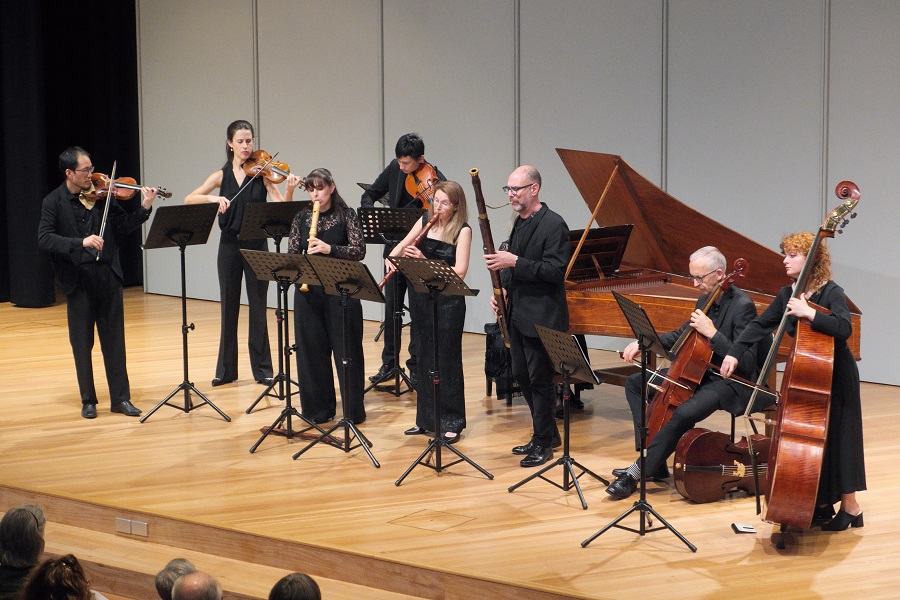
Music / The Networker, Salut! Baroque. At National Gallery of Australia, October 11. Reviewed by ROB KENNEDY.
The latest Salut! Baroque concert was a celebration of Johann Georg Pisendel, his networking ability and his remarkable 43-year tenure in the Dresden Court Orchestra, renowned as Europe’s most famous orchestra in the 18th century.
The performers were, Sally Melhuish and Alicia Crossley, recorders; Jane Downer, baroque oboe and recorder; Ben Hoadley, baroque bassoon and recorder; John Ma, baroque violin; Ella Bennetts, baroque violin; Brad Tham, baroque viola; Tim Blomfield, baroque cello; Julia Magri, baroque double bass and Monika Kornel, harpsichord.
Opening with Pisendel’s Imitation des Caractères de la Danse, in eight short movements that blended beautifully into one another, the balance of tones from high to low was intermixed with the entertaining and thrilling varying dance pieces. It highlighted the music of a beguiling composer.
Mellow and tranquil, the adagio ma non troppo from Quadro O Haupt voll Blut und Wunden, by Johann Gottlieb Janitsch, with a floating oboe between the strings and harpsichord, created a relaxing and sublime pastoral setting, which left a soothing feeling.

The Concerto for Bassoon FaWV L:c2, by Johann Friedrich Fasch, in three movements, where the bassoon soon took the lead, but in dialogue with the oboe, this gorgeous period piece flaunted the unique quality of just how stylish baroque music is, and how the bassoon helps create that ancient experience. Unlike contemporary concertos where the lead instrument gets a showy, powerful solo, the bassoon was the backbone of the music, yet still stood out. It was performed with great authority by Hoadley.
Georg Philipp Telemann’s Concerto in B minor for two flutes and bassoon followed. Playing just two movements, the grave and allegro, the recorders cut through with their smooth tones, and the bassoon underneath. At times, with just the three playing, their harmonies and tunes transported a listener into another time.
Then Sonata a cinque in G minor Op. 2 No. 11, by Tomaso Albinoni, another work in a minor key, but in four movements for just strings and harpsichord. With John Ma on first violin, acting like a solo instrumentalist, he led as the others repeated and followed. An energetic work mixed with the slowest of sad songs created a harmonious balance of sound.
Jan Dimas Zelenka’s Miserere in C minor, just numbers I and III for all 10 players was more driving than sad. Over repeating bass lines, the four woodwinds created long heartfelt expressions. The contemporary British composer Michael Nyman must have heard this work because it was so him.
Johann Melchior Molter’s Concerto in Bb Major for four recorders, also had cello and harpsichord. Led expertly by Alicia Crossley, this was a treat. The harmonious sounds of a quartet of recorders are not heard often enough in any concert. This was the standout work of the night.
What’s to say about the Air on the G string by Johann Sebastian Bach? For just harpsichord and strings, even after around 300 years since inception, it still moves.
Finishing with Antonio Vivaldi’s Concerto in G minor RV107, just the Largo and Allegro were a bit like a concerto for seven instruments. The three strings, three woodwind and harpsichord, had independent lines making a unique final work. Like the music and composers, Salut! Baroque networked beautifully.
Who can be trusted?
In a world of spin and confusion, there’s never been a more important time to support independent journalism in Canberra.
If you trust our work online and want to enforce the power of independent voices, I invite you to make a small contribution.
Every dollar of support is invested back into our journalism to help keep citynews.com.au strong and free.
Thank you,
Ian Meikle, editor



![For graphic designer Tracy Hall, street art is like any artwork, her canvas has been swapped out for fences and plywood, her medium changing from watercolours to spray paint.
A Canberra resident for 13 years, Tracy has been a street and mural artist for the past five.
Her first exploration into grand-scale painting was at the Point Hut toilets in Banks five years ago. “They had just finished doing up the playground area for all the little kids and the words [of graffiti] that were coming up weren’t family friendly,” she says.
“So I ended up drawing this design and I got approval for the artwork.”
Many of Tracy’s time-consuming artworks are free, with thousands of her own dollars put into paint.
@traceofcolourdesigns
To read all about Tracy's fabulous street art, visit our website at citynews.com.au or tap the link in our bio! 🎨🖌
#canberranews #citynews #localstories #canberrastories #Citynews #localnews #canberra #incrediblewomen #journalism #canberracitynews #storiesthatmatter #canberralocals #artist #streetart #streetartist #StreetArtMagic](https://scontent.cdninstagram.com/v/t39.30808-6/490887207_1225841146218103_6160376948971514278_n.jpg?stp=dst-jpg_e35_tt6&_nc_cat=106&ccb=1-7&_nc_sid=18de74&_nc_ohc=yse5ujF1BOUQ7kNvwE8vMJJ&_nc_oc=AdmACWW3pCwuhoAJjTJgeYL0PrOjZetex1flAsV7seJ8OPT1_w_DCdBrY998OXsAdFw&_nc_zt=23&_nc_ht=scontent.cdninstagram.com&edm=ANo9K5cEAAAA&_nc_gid=M3Eat5CavCFLyQKem8wl7A&oh=00_AfEelLohW-0BM38EPlPqLO_ehfn2HbeGBZ7_42rmOJ7w8w&oe=68079794)




Leave a Reply